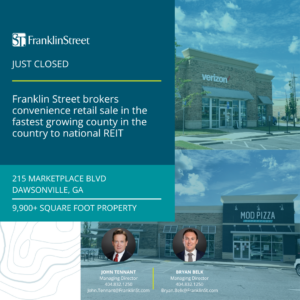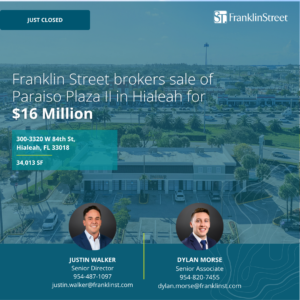Broward County multifamily housing and retail is undergoing a remarkable transformation as millennials and empty nesters are embracing urban living and young professionals seek similar experiences in suburban settings.
Having been built out for some time, much of the development in Broward has shifted from gated communities in western suburbs to multifamily housing in the urban core. About 4,000 condominium and apartment units in 20 blocks of Fort Lauderdale are set to come online in the next few years.
Most of the new properties will resemble The Manor at Flagler Village, a mixed-use complex with residential units between 700 and 1,350 square feet. Rents range from $1,826 to$2,921 per month, about 30 percent higher than other nearby Class A buildings. The retail component, which is managed by Franklin Street, occupies the first floor and includes popular restaurants such as The Brass Tap, a craft brewery and Mellow Mushroom. Other service-based retailers range from a dentist office and fitness center to nail and hair salons. Nearby is a Fresh Market grocery store, a museum and parks. These amenities appeal to millennials.
Young adults are looking for the best apartment spaces available regardless of unit size. Millennials care more about the fact that there’s a restaurant that they like in the lobby and Wi-Fi access throughout the entire building.
Their interests are altering the retail environment. Traditional retail is being replaced with service-oriented businesses where people can eat, have a drink, get their nails done or meet with a financial advisor.
Baby boomers want similar amenities. Many retirees are selling their four-bedroom houses in the suburbs and moving into an apartment where they don’t have to worry about things like lawn care. They can travel for pleasure or to visit grandchildren and want the freedom that comes from not owning a home.
As part of the population move to the downtown core, more people are doing something unusual in South Florida: they are giving up their cars. With easy access to ride-sharing programs, consumers are taking the money budgeted for a vehicle and putting it toward rent instead.
Broward municipalities such as Coral Springs and Plantation are following suit. An urban core is emerging in Coral Springs centered around a new downtown city hall that is under construction and over 300 apartments have been built. One is Bainbridge at Coral Springs, a five-story development with top-of-the-line amenities and rents $300-$700 a month less than in downtown Fort Lauderdale.
Properties like that attract young professionals. Millennials that have small children prefer neighborhoods with A-rated schools. While some couples have started families, they are still active and want to go out and socialize with their friends in places like those in downtown Fort Lauderdale.
They’re attracted to places such as Plantation Walk, which will go up on the site of the former Plantation Fashion Mall. Plans call for 700 rental apartments, 200,000 square feet of retail and a Class-A office tower. It appeals to young people who don’t want to travel 25-plus minutes to downtown Fort Lauderdale for work or fun. They would prefer a short walk or ride to their office and to have restaurants, bars and shopping close to home.
Multifamily investors have noticed the trend and started to grow their portfolios. Demand has so outstripped supply that an investor that would normally purchase a Class A or Class B property in an established area is going out of their comfort zone and buying a Class C property in an emerging neighborhood.
In Broward County, much of the buyer interest is coming from out-of-area investors working with local conduits. When Franklin Street recently marketed 167 units in downtown Plantation, we garnered about 17 written offers in two weeks, half of them from investors in New York, Philadelphia, New Jersey and Canada.
Outsiders are active in Florida for two reasons: The first is cap rate compression. Investors are seeing deals at 1 to 2 percent, and at zero percent in some cases in New York. Florida cap rates are also being squeezed, but they are still at 5-6 percent.
Second, Florida offers significant tax benefits. Out-of-state investors can re-capitalize their portfolios, sell their properties at a premium, come down here, and trump everybody at the local market level.
Today’s investors are not looking for immediate cash. Many are buying properties in neighborhoods that they think are up and coming. These buyers expect that their apartments or mixed-use buildings will be smack in the middle of a redevelopment play five to 10 years down the line. Given current trends, they are likely to be right.
Hernando Perez is Director of Multifamily Investment Sales at Franklin Street. Dan Dratch is an Investment Associate who specializes in the acquisition and disposition of multifamily properties across South Florida.



